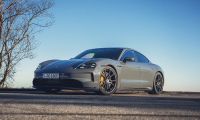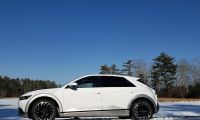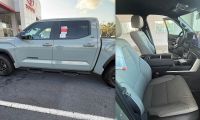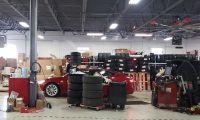Electric trucks are no longer the stuff of Silicon Valley daydreams or the exclusive playthings of eco-conscious venture capitalists. They’re here, prowling highways, lurking at Walmart chargers, and, crucially, bumping against one another in the war for the suburban garage. Nowhere is this clearer than with the GMC Sierra EV, a vehicle that manages to be, in the modern American sense, both “great” and “expensive” with equal enthusiasm. But what does that mean for the average truck buyer, or for those with feet in the EV world already?

On paper, and for $80,000 and up, the Sierra EV is pure GM theater. This is a truck that comes with the stance, the face, and the kind of technological posturing (rear-wheel steering, crab walk, power-out mode) designed as much for dinner party anecdotes as for real-world utility. And yet, beneath all that, it’s a careful bit of cannibalization. The Sierra EV exists not merely as a fresh flagship, but as a calculated swipe at the Hummer EV, raiding its own stable for conquest sales and in the process, muddying the brand’s sense of exclusivity and purpose.
Modular Architecture, 800V Fast-Charging & Innovative Features
- The Sierra EV utilizes GM's Ultium platform, a flexible and scalable architecture designed to accommodate various vehicle types and performance needs. This modularity allows for different battery configurations and drive units, enabling the Sierra EV to achieve impressive specifications like up to 460 miles of range and 760 horsepower in the Denali Max Range variant .
- The Ultium battery pack serves not only as a power source but also as a structural element of the vehicle. Its placement lowers the truck's center of gravity, enhancing ride comfort and driving confidence both on and off the road . Additionally, the platform supports 800V DC fast charging, allowing the Sierra EV to add approximately 100 miles of range in just 10 minutes .
- The Sierra EV incorporates several unique features made possible by the Ultium platform. These include the MultiPro Midgate, which extends the truck bed into the cabin for increased cargo space, and the Power Station Pro, offering up to 10.2 kW of off-board power to run tools or even power a home during outages . Such innovations blend practicality with luxury, redefining expectations for electric trucks
Look past the styling and badge, and you’ll see the truth: this Sierra is the Chevy Silverado EV’s doppelgänger. Both ride on the same Ultium platform, both have identical battery packs and drivetrains, both deliver earth-moving torque and outlandish features. The only real daylight between them is the marketing, one in “professional grade” sheet metal, the other in blue-collar clothes. It’s badge engineering as old as the industry itself, updated for the world of kilowatts and range anxiety. For buyers, the distinction between Sierra and Silverado EV is a matter of taste and price, not substance.
10,000 Miles in the GMC Sierra EV
But statistics and spec sheets only tell part of the story. The real measure of any modern truck, electric or otherwise, comes from those putting down real miles. Cyle Hendricks, a top contributor to the GMC Sierra EV Group, recently clocked 10,000 miles behind the wheel and shared his candid take:
“Just hit 10k miles.
PROs - This thing is a road trip beast. The charging and range performance have been awesome. There is this 200+ mile stretch where there is only a 60kw chargepoint and in 0 degree weather, I was safely able to pull off 85% to 5-10%. And that is its biggest strength. I also love rear-wheel steering, and I almost do not want to go to another large vehicle such as this without it.
The rear view camera mirror, Google maps integration, HUD [if that matters to you], and overall build materials.
Coming from the Lightning, one thing I appreciate is when I watch the video and the audio is streamed through Bluetooth, there is no delay.”
In an era where electric range is the all-consuming metric, Hendricks’ experience is significant. The Sierra EV tackles harsh, real-world conditions, long, charger-sparse stretches, and bitter cold, with a level of composure that would have been unthinkable a decade ago. GM has quietly, stubbornly built a true road-trip machine. There’s no fanfare, no ego. It simply works, and that’s the highest praise you can give any truck.
But the story doesn’t end there. For every mile of seamless range, there’s a rattle in the dash or a frustrating tap in the app. Cyle’s verdict is honest:
“CONs- the app needs work. A LOT of work. I hate that, say if I am camping, I can only keep the truck on at 1-hour intervals. And any more than one time trying to start the climate with the app, and it does not work [this occurs in my Ford Lightning as well]. This thing is a rattle machine. More rattles than any Tesla and the Rivian R1T that I owned. The midgate is a gimmick. GMC and any non-Tesla/Rivian manufacturer needs to stop with the gimmicks, that, and cthe rab walk. The rear floor is not totally flat, and because of the midgate feature, when you pull up the seats, you have all that stuff in place because of the midgate function. Some annoying software bugs, such as crackling when listening to music. Fit and finish issues have also plagued this thin,g such as trim alignment issues and driver's side wind noise.”
Software & Fit-Finish Challenges in the Sierra EV
According to him, GM nails the engineering but stumbles over software and interior quality.

This same sentiment can be echoed on some forums, including this one.
So recently purchased a 2024 GMC Sierra 1500, and noticed I have rattling sound when I drive it comes and goes and sounds like it's coming from the front passenger side, I think it's either the exhaust or possible the front shock. Has anyone else had this issue before with any of the 19-24 models? And if so what was wrong with your truck?
The app is “a hot mess.” The midgate, ostensibly a trump card, is called a “gimmick.” Meanwhile, rattles and trim alignment gripes keep the experience just shy of seamless. It’s a distinctly Detroit kind of problem: deliver the hardware, but pray the software keeps up.
Tesla Touchscreen, Rivian/Polestar Controls & Physical Buttons
- Tesla has set a benchmark with its sleek, responsive UI. Central to this is a large touchscreen that consolidates controls, from navigation to climate settings. This design mirrors the simplicity of smartphones, offering over-the-air updates that enhance functionality over time. However, some users find the reliance on touchscreens for basic functions, like adjusting vents, less intuitive.
- Brands like Rivian and Polestar are carving their niches. Rivian combines traditional controls with digital interfaces, aiming for a balance between familiarity and innovation. Polestar integrates Google's Android Automotive OS, providing a seamless experience for users familiar with Google's ecosystem. While these approaches offer flexibility, they sometimes lack the cohesive feel of Tesla's in-house system.
- A growing segment of drivers and manufacturers advocate for the reintroduction of physical buttons, citing safety and ease of use. Brands like Mazda and Hyundai have maintained or reintroduced tactile controls, responding to concerns that touchscreens can be distracting. This trend highlights the industry's effort to balance modern aesthetics with functional design.
Which brings us to price. The Sierra EV’s $80,000-and-climbing sticker nudges it dangerously close to the Hummer EV, creating a kind of internal arms race that leaves the buyer bewildered. If you’re already spending six figures, why not swing for the Hummer’s bravado, or, for that matter, the Rivian R1T’s modernity and richer accessory support? As Cyle puts it,
“When it comes to Tesla and Rivian, it is just a smoother, cohesive experience [app, software, accessory support]. And I doubt we will see any accessory support like we see on Tesla and Rivian.”
The American truck market has always thrived on culture and community. GM, for all its heritage, is playing catch-up on both.
On the Sierra EV forums, the dialogue is refreshingly honest. Owner Robert Bloomer points out a hidden feature for “power out” mode, while Joe Baliski wants to know, plain and simple, if the Sierra trumps the Lightning. Cyle replies:
“Overall, yes. I still prefer the ride quality, the more open space when seats are up in the back, and opening back windows in the Ford.”
Weighing the GMC Sierra EV’s Strengths Against Its Rough Edges
So, it’s complicated. There are bright spots and tradeoffs. There is no perfect answer, only the constant recalibration of expectations.
The final analysis? The Sierra EV is a superb road warrior with real strengths: impressive range, strong charging, and genuinely useful rear-wheel steering. But it’s also plagued by the kind of fit, finish, and software frustrations that keep it a rung below Rivian, at a price point that makes those flaws sting. If you want a luxury-priced EV truck and can stomach some rough edges and “gimmicks,” this GMC delivers. But if you want the full, seamless, next-gen EV experience, well, there’s always the Rivian, waiting at the next charger.
Are you happy with the experience your electric vehicle provides? How did you find out you wanted an EV?
Tell us in the comment section below why you love your current EV.
Image Sources: GMC Newsroom
Noah Washington is an automotive journalist based in Atlanta, Georgia. He enjoys covering the latest news in the automotive industry and conducting reviews on the latest cars. He has been in the automotive industry since 15 years old and has been featured in prominent automotive news sites. You can reach him on X and LinkedIn for tips and to follow his automotive coverage.













Comments
I use my GMC trucks for work…
Permalink
I use my GMC trucks for work there's no reason I want to have a rear wheel steering on any of my trucks if you know how to drive a truck that's a completely useless feature. All these stories that keep getting posted on how great the EV Sierra and Silverado are are from people that don't use the truck for a truck. You need an article from people that use and work their trucks Daily.
I would avoid the city…
Permalink
I would avoid the city paradox with an EV because I could actually charge one at home in my garage.
But these trucks are paradoxically too big for my garage in town anyway.
I guess wealthy guys in the country with three car garage McMansions need EVs too.